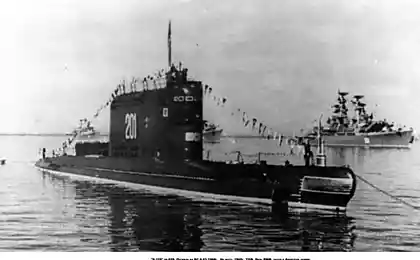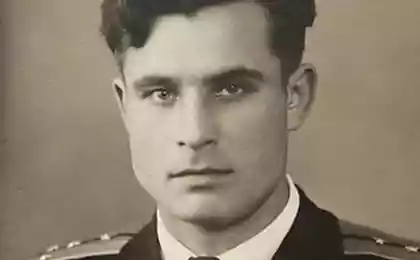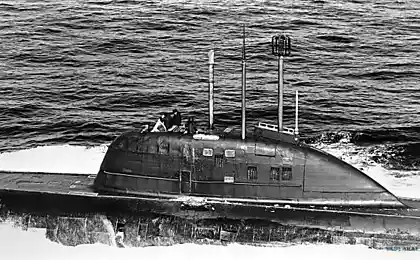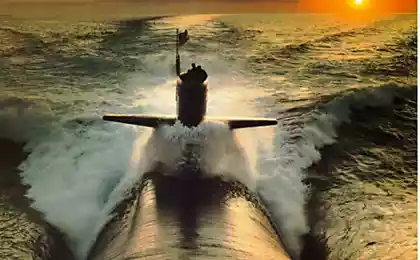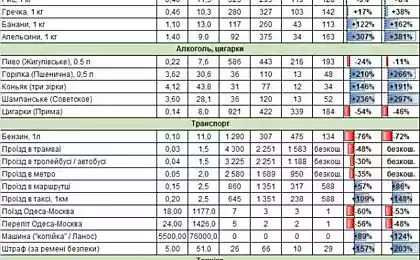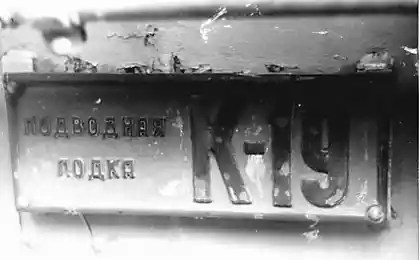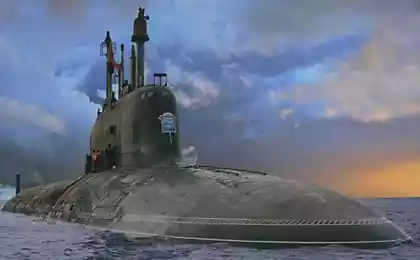17914
Climbing nuclear submarine K-129 (21 photos)
"Project Azorian" - the code name for a covert operation, which later became one of the major scandals of the Cold War. It was in those early years disguised USS pulled from the ocean drowned Soviet K-129. On a dark day in the North Pacific lie the remains of the most courageous submarine in history. These fragments show the terrible tragedy that occurred March 11, 1968 with the Soviet nuclear submarine K-129, which killed 98 officers. Scene of the tragedy was kept secret from the Soviet Union and only after 6 years was announced ...
Americans found and examined the sunken submarine during the first 2 weeks. With modern technology, the CIA launched a unique project for raising from the seabed of the boat K-129 in August 1974.
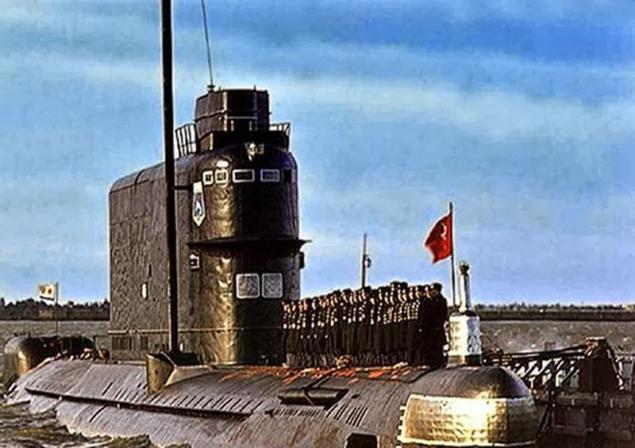
Since K-129 sank in very deep water, about 5000 m, especially for the operation was designed and built ship Glomar Explorer, equipped with a unique equipment for ultra-deepwater operations. The operation was carried out secretly in international waters and was disguised as exploration offshore.
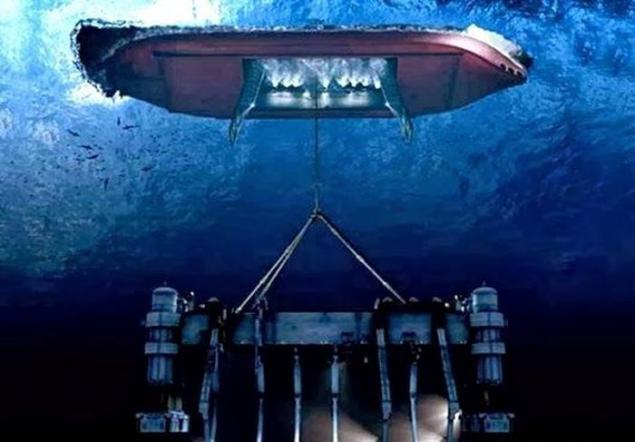
Course trouble
... Under the cover of darkness early morning 24 February 1968 diesel-electric submarine "K-129" tail number "574", left Krasheninnikov bay and headed into the Pacific Ocean to the Hawaiian Islands.
Submarine Project 629-A. Limiting diving depth - 300 m. The arms - 3 ballistic missile R-21 torpedoes with nuclear warheads. Endurance -70 days. The crew - 90 people.

On March 8, at the turning point of the route, the submarine did not signal a passing reference abroad. A faint hope that the boat is drifting on the surface, devoid of stroke and radio petered out after two weeks.
Began in earnest a major search operation. Over 70 days three dozen ships of the Pacific Fleet examined the entire route "K-129" on the way from Kamchatka to Hawaii. All the way took water samples for radioactivity (on board the submarine was nuclear weapons). Alas, the boat sank into obscurity.
The crew of the lost boat.
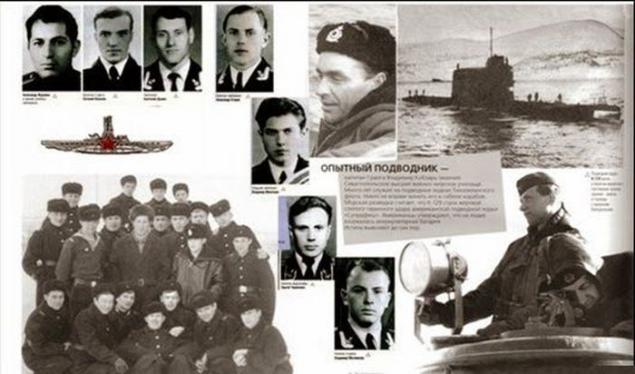
In the autumn of 1968 families of the missing sailors from the crew of "K-129" cities of the Soviet Union were sent mournful notice where in the "cause of death" means "presumed dead". The disappearance of the submarine military and political leadership of the USSR hid from the world, quietly eliminating "K-129" from the Navy.
The only one who remembered about the dead boat was US Central Intelligence Agency.
Abraham
Nuclear submarine «Barb» (SSN-596) were on duty in the Sea of Japan when something unexpected happened. In the sea came a large group of Soviet ships and submarines. Surprising that the Soviet Navy sonar ships, including submarines, constantly "worked" in the active mode.
It soon became clear that the Russian was not looking for the American boat. Their ships quickly shifted to the east, filling the airwaves numerous reports. The commander of the USS «Barb» Command reported the incident and suggested that, judging by the nature of the "event" Russian searching for their sunken boat.
Place of death of K-129
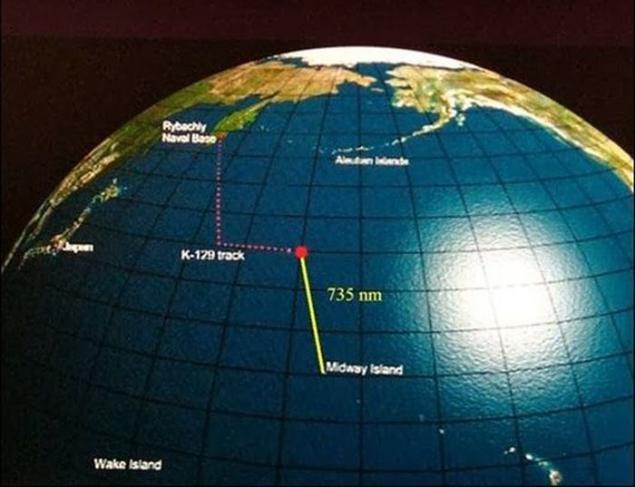
Specialists of the US Navy began to listen kilometers tapes obtained from the bottom of the acoustic system stations SOSUS. In the cacophony of the ocean they found a fragment which was recorded "cotton".
The signal received from the bottom station on the elevation of the Imperial Mountains (part of the ocean floor) at a distance of over 300 miles from the alleged crash site. Taking into account the bearing accuracy SOSUS in 5-10 °, to "K-129" was defined as a "spot" size of 30 miles.
Soviet submarine sank 600 miles north-west of. Midway (Hawaiian Islands), the middle of the ocean trench at a depth of 5000 meters.
Solution
Official government's refusal of the USSR from the sunken "K-129" has led to the fact that she was "abandoned property", so any country, to locate a missing submarine, was considered to be its owner. Therefore, at the beginning of 1969, the CIA began discussions about the possibility of recovery of valuable equipment from the Soviet submarine from the bottom of the Pacific Ocean.
Americans interested in everything: the design of the submarine, mechanisms and tools, sonar, and documents. Special temptation suggestive penetrate the radio of the Soviet Navy, "split" the radio codes.
If it is possible to remove the radio communication equipment, you can use the computer to reveal information coding algorithms, the key to understand the laws of the development of codes of the USSR, ie, open the entire system deployment and management of the Navy of the Soviet Union. No less interesting is nuclear weapons on board the boat: design features of R-21 ICBM combat units and torpedoes.
By July 1969 was ready to clear plan for several years ahead, and work has begun to boil. Given the enormous depth at which sank "K-129", the success of the operation was estimated at 10%

Mission Helibat
For a start it was necessary to establish the exact whereabouts of the "K-129" and assess its condition. It took nuclear submarine special operations USS «Halibut» (Halibut).
Former missile was thoroughly modernized and saturated "eyeballs" oceanographic equipment: side thrusters, anchor gear with bow and stern mushroom anchor, diving camera near and far side sonar and deep-towed unit «Fish», equipped with photographic, video -Equipment and powerful searchlights.
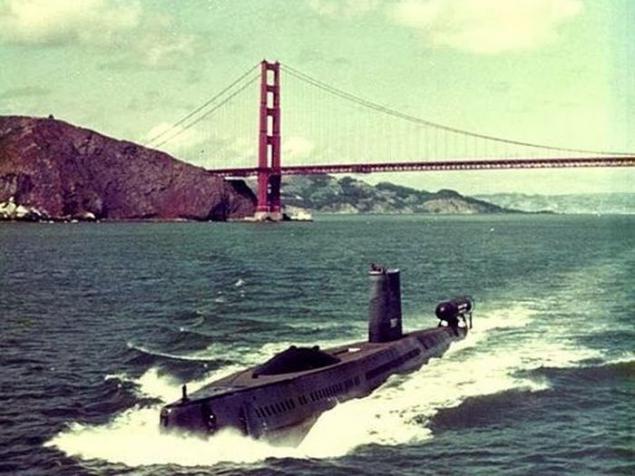
When "Helibat" was at the design point, pulled the days of hard work. Every six days raised deep-sea vehicle to recharge in-camera film. Then she worked at a furious pace lab (the camera takes 24 frames per second).
And once on the table lay a picture with clearly defined rudder submarine. "K-129" lay down on the bottom of the ocean to unofficial reports at 38 ° 5 'N and 178 ° 57 '. d. (according to other sources - 40 ° 6 'with.. and 179 ° 57' in. d.) at a depth of 16,500 feet.
The exact coordinates of the "K-129" are still a state secret US. Following the discovery of "K-129", "Helibat" took another 22 thousand pictures of Soviet submarine.
Originally it was planned by a remotely operated underwater vehicles to open the enclosure "K-129" and retrieve the US intelligence materials on board the submarine without lifting most boats. But during the mission "Helibat" it was found that building "K-129" fractured into several large fragments, which made it possible to raise the entire interest to scouts compartments with five-kilometer depth.
Of particular value is the nose of the "K-129" in length 138 feet (42 meters). CIA and Navy appealed for financial support in the Congress, the Congress - President Nixon, and the project became a reality AZORIAN.
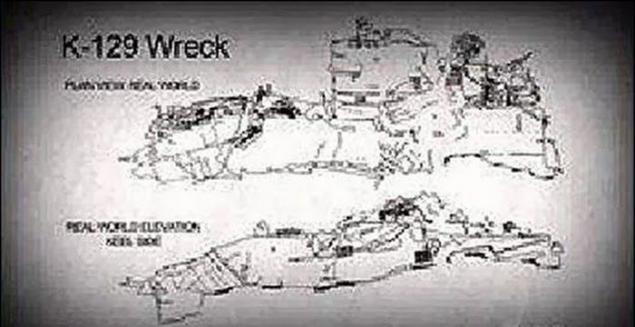
History GSF Explorer
Fantastic project required special technical solutions.
In April 1971, the shipyard Shipbuilding Dry Dock Co. (Pennsylvania, US East Coast) was laid ship MV Hughes Glomar Explorer. Giant, full displacement of 50,000 tons, was a single-deck vessel with a "central slot" on which was placed a huge A-shaped tower, located aft, fore and aft bunk chetyrёhyarusnoy superstructures.
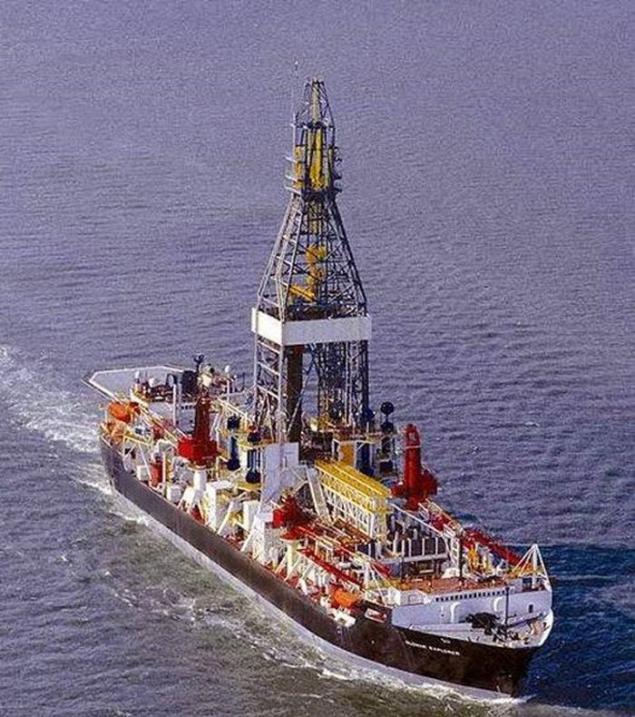

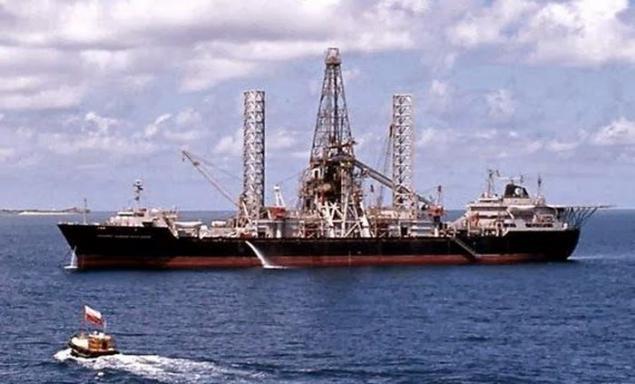
Almost a third vessel held "Moon Pool" sizes 60, 65 x 22, 5 x 19 8 m, which served as a dock to accommodate deep-water capture, and then raised parts of the submarine. Filled with water, it looked like a giant swimming pool, with the exception of cranes on every corner. Bottom pool closed doors with rubber seals.

The layout on the deck of the ship «Hughes Glomar Explorer» basic equipment used in the installation of pipe columns (riser): 1 overhead crane; 2 main deck; 3- "moon pool"; 4-A-shaped frame; 5 outer gimbal suspension; 6 inner gimbal suspension; 7-base cargo handling system; 8-tower; 9 trubopodayuschy tray; 10-tray trolley trubopodayuschego; 11 truboperegruzochny tap; 12-lift pipe.
One of the myths about the project "Azorian" - "K-129" snaps when lifting and most fell to the bottom - refuted size mismatch "moon pool" (length 60 meters) and the length of the body "K-129" (at design waterline length - 99 meters). Already was originally planned to be raised only a part of the submarine.
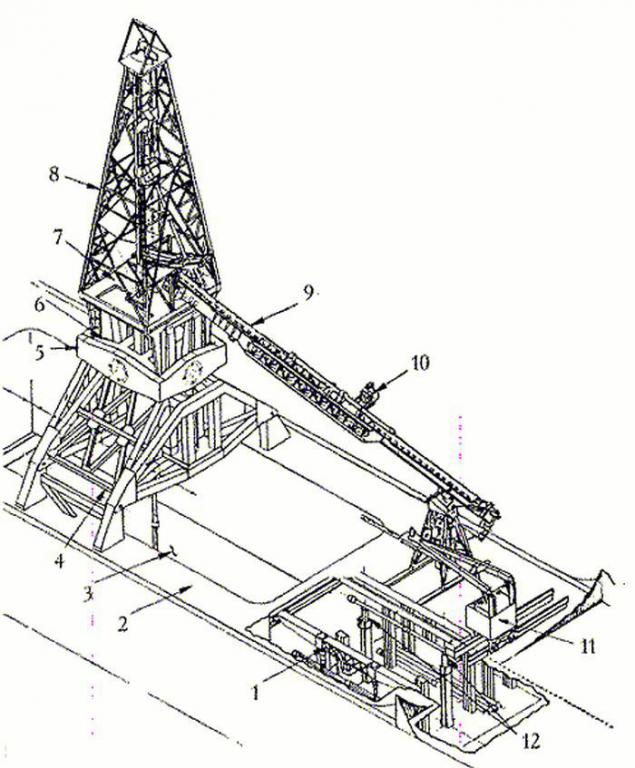
According to the center plane, the nose and aft of the center slots were installed movable column for receiving gripper submerged barge. They resembled in appearance outriggers on offshore drilling rigs, and according to the authors, were mislead observers of this strange vessel that he initially failed.
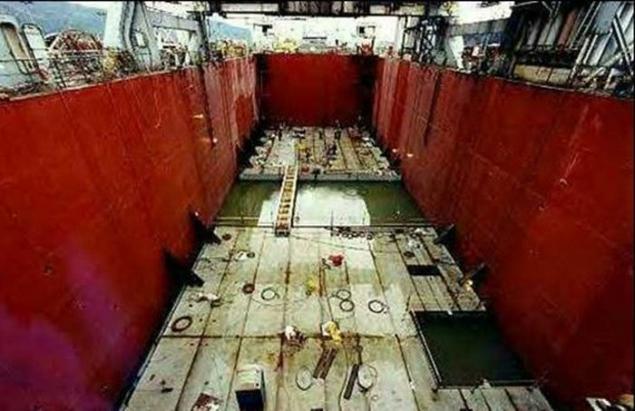
Since May 11, 1975 in the journal "Parade" was a photograph of the vessel «MV Hughes Glomar Explorer» with the statement that these columns are based on the bottom. Later analysis of foreign publications allowed Soviet specialists to determine their true purpose.
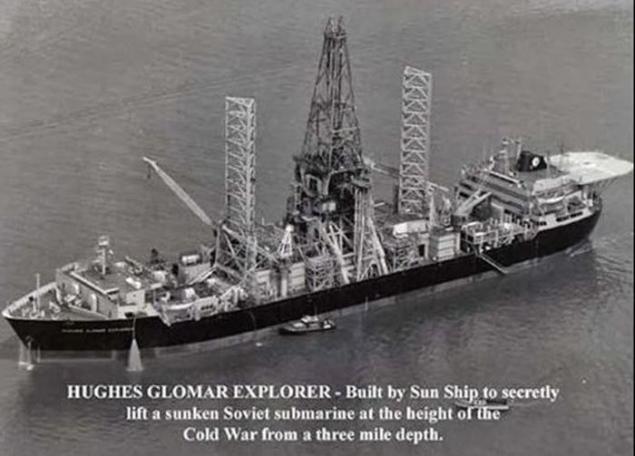
Contract for the design of the vessel CIA has concluded with the company Hughes Tool Co. The choice of this company was not accidental. It was her head Howard Hughes, the billionaire adventurer, best suited for the role of the main organizer and creator of this ambitious undertaking.
Just at Hughes created the first laser, and then the first American satellites. Missile guidance systems, three-dimensional radars - all this made the company Hughes. In 1965-1975 gg. contracts with DoD only company Hughes Aircraft were 6 bln. dollars.
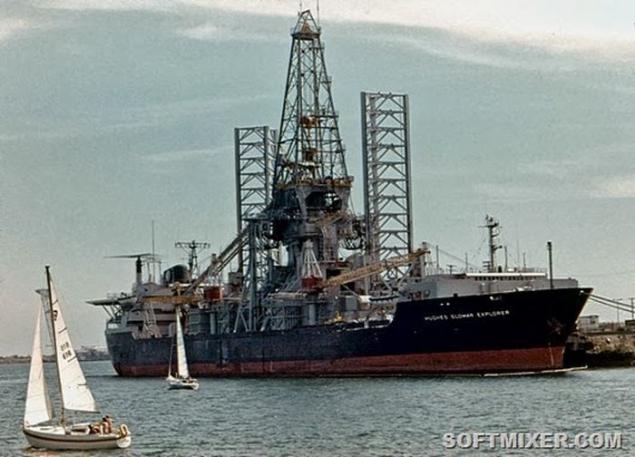
At the same time, the shipyards National Steel Shipbuilding Corp. San Diego (California, Zap. Coast of the US) was built barge HMB-1 (Hughes Marine Barge) and deep capture Clementine. Such dispersal of production ensures complete covert operations.
Even engineers are directly involved in the project alone could not understand the purpose of these devices (the ship, capture and barges).
After a series of tests on the East Coast, August 13, 1973 "GSF Explorer" went to the 12,000-mile cruise bypassing m. Horn and 30 September safely arrived in Long Beach (CA). There, away from prying eyes, in a quiet bay of the island of Santa Catalina his waiting barge HMB-1 with the attached seizure.
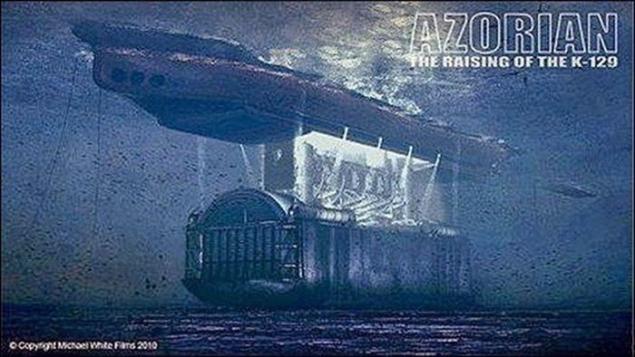
Loading process "Clementine" on Glomar Explorer
Barge slowly loaded and recorded at a depth of 30 m above it stood "GSF Explorer"; flaps its central connector and pushed the two columns was lowered into the water; at this time the roof was opened barges, and columns, as chopsticks when eating, moved the "Clementine" into the vessel - in "Moon Pool".
Once the seizure came on board the ship were closed massive underwater wing and pumped water from the indoor pool. After that, the ship began a huge, invisible to prying eyes, work on installation of capture, joining all cables, hoses and sensors.

Clementine
Cold Summer of 1974, trough the north of the island of Guam in the western Pacific Ocean. The depth of 5000 meters ... Every 3 minutes a crane served long sections 18, 2 m. Total of 300 sections, each strong as gun barrel.
Lowering and raising deep-capture "Clementine" is derived by means of the tubular string - the riser pipe, a length of 5 kilometers. Each pipe section has a conical cutting, section thoroughly screwed into one another, the grooves provide a secure locking of the assembly.
The actions of the "Glomar Explorer" watched with interest the Soviet seamen. The very purpose of the operation for them is not clear, but the fact of the deepwater in the middle of the Pacific Command aroused the suspicion of the Soviet Navy.
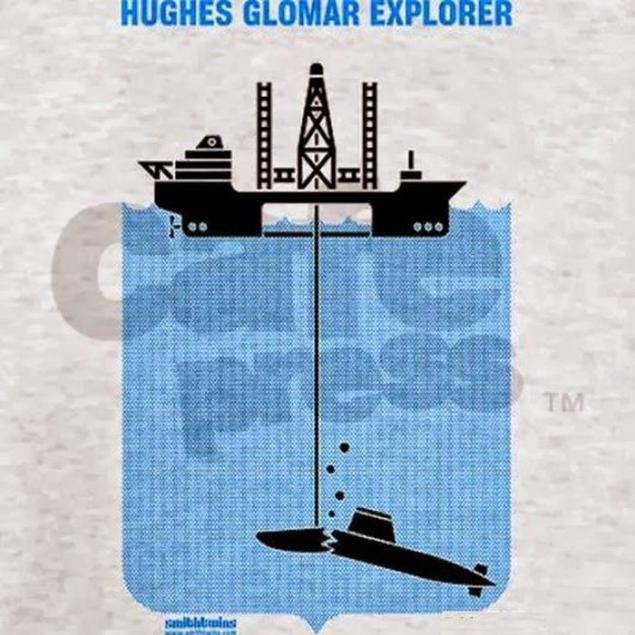
As a result of technical problems during its ascent boat hull broke and most of sank again, finally destroyed by contact with the ground, on board the "Glomar Explorer" was raised only the bow section.
Although official information remains secret, the researchers believe that ballistic missiles, codebooks and other equipment left on the bottom, so it is believed that the purpose of the operation have not been fully achieved.
Are nearby Tracking ship "Chazhma" and rescue tug SB-10 brought the Yankees a lot of trouble. Because of fears that Russian will take "GSF Explorer" storm, had to fill up boxes helipad and rouse the whole crew.
Worrying data comes from "Moon pool" - radioactive debris boats obviously collapsed one of nukes.
"Clementine" with parts of "K-129" coming on board the vessel, "Glomar Explorer" and walks away with their booty to Hawaii ...
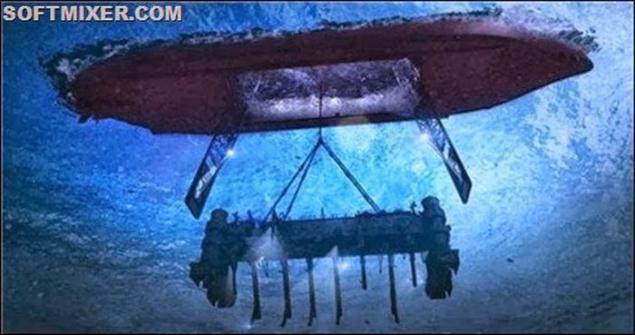
Memorial to submarine "K-129" in the garrison Vilyuchinsk

Source: ussrlife.blogspot.ru
Americans found and examined the sunken submarine during the first 2 weeks. With modern technology, the CIA launched a unique project for raising from the seabed of the boat K-129 in August 1974.

Since K-129 sank in very deep water, about 5000 m, especially for the operation was designed and built ship Glomar Explorer, equipped with a unique equipment for ultra-deepwater operations. The operation was carried out secretly in international waters and was disguised as exploration offshore.

Course trouble
... Under the cover of darkness early morning 24 February 1968 diesel-electric submarine "K-129" tail number "574", left Krasheninnikov bay and headed into the Pacific Ocean to the Hawaiian Islands.
Submarine Project 629-A. Limiting diving depth - 300 m. The arms - 3 ballistic missile R-21 torpedoes with nuclear warheads. Endurance -70 days. The crew - 90 people.

On March 8, at the turning point of the route, the submarine did not signal a passing reference abroad. A faint hope that the boat is drifting on the surface, devoid of stroke and radio petered out after two weeks.
Began in earnest a major search operation. Over 70 days three dozen ships of the Pacific Fleet examined the entire route "K-129" on the way from Kamchatka to Hawaii. All the way took water samples for radioactivity (on board the submarine was nuclear weapons). Alas, the boat sank into obscurity.
The crew of the lost boat.

In the autumn of 1968 families of the missing sailors from the crew of "K-129" cities of the Soviet Union were sent mournful notice where in the "cause of death" means "presumed dead". The disappearance of the submarine military and political leadership of the USSR hid from the world, quietly eliminating "K-129" from the Navy.
The only one who remembered about the dead boat was US Central Intelligence Agency.
Abraham
Nuclear submarine «Barb» (SSN-596) were on duty in the Sea of Japan when something unexpected happened. In the sea came a large group of Soviet ships and submarines. Surprising that the Soviet Navy sonar ships, including submarines, constantly "worked" in the active mode.
It soon became clear that the Russian was not looking for the American boat. Their ships quickly shifted to the east, filling the airwaves numerous reports. The commander of the USS «Barb» Command reported the incident and suggested that, judging by the nature of the "event" Russian searching for their sunken boat.
Place of death of K-129

Specialists of the US Navy began to listen kilometers tapes obtained from the bottom of the acoustic system stations SOSUS. In the cacophony of the ocean they found a fragment which was recorded "cotton".
The signal received from the bottom station on the elevation of the Imperial Mountains (part of the ocean floor) at a distance of over 300 miles from the alleged crash site. Taking into account the bearing accuracy SOSUS in 5-10 °, to "K-129" was defined as a "spot" size of 30 miles.
Soviet submarine sank 600 miles north-west of. Midway (Hawaiian Islands), the middle of the ocean trench at a depth of 5000 meters.
Solution
Official government's refusal of the USSR from the sunken "K-129" has led to the fact that she was "abandoned property", so any country, to locate a missing submarine, was considered to be its owner. Therefore, at the beginning of 1969, the CIA began discussions about the possibility of recovery of valuable equipment from the Soviet submarine from the bottom of the Pacific Ocean.
Americans interested in everything: the design of the submarine, mechanisms and tools, sonar, and documents. Special temptation suggestive penetrate the radio of the Soviet Navy, "split" the radio codes.
If it is possible to remove the radio communication equipment, you can use the computer to reveal information coding algorithms, the key to understand the laws of the development of codes of the USSR, ie, open the entire system deployment and management of the Navy of the Soviet Union. No less interesting is nuclear weapons on board the boat: design features of R-21 ICBM combat units and torpedoes.
By July 1969 was ready to clear plan for several years ahead, and work has begun to boil. Given the enormous depth at which sank "K-129", the success of the operation was estimated at 10%

Mission Helibat
For a start it was necessary to establish the exact whereabouts of the "K-129" and assess its condition. It took nuclear submarine special operations USS «Halibut» (Halibut).
Former missile was thoroughly modernized and saturated "eyeballs" oceanographic equipment: side thrusters, anchor gear with bow and stern mushroom anchor, diving camera near and far side sonar and deep-towed unit «Fish», equipped with photographic, video -Equipment and powerful searchlights.

When "Helibat" was at the design point, pulled the days of hard work. Every six days raised deep-sea vehicle to recharge in-camera film. Then she worked at a furious pace lab (the camera takes 24 frames per second).
And once on the table lay a picture with clearly defined rudder submarine. "K-129" lay down on the bottom of the ocean to unofficial reports at 38 ° 5 'N and 178 ° 57 '. d. (according to other sources - 40 ° 6 'with.. and 179 ° 57' in. d.) at a depth of 16,500 feet.
The exact coordinates of the "K-129" are still a state secret US. Following the discovery of "K-129", "Helibat" took another 22 thousand pictures of Soviet submarine.
Originally it was planned by a remotely operated underwater vehicles to open the enclosure "K-129" and retrieve the US intelligence materials on board the submarine without lifting most boats. But during the mission "Helibat" it was found that building "K-129" fractured into several large fragments, which made it possible to raise the entire interest to scouts compartments with five-kilometer depth.
Of particular value is the nose of the "K-129" in length 138 feet (42 meters). CIA and Navy appealed for financial support in the Congress, the Congress - President Nixon, and the project became a reality AZORIAN.

History GSF Explorer
Fantastic project required special technical solutions.
In April 1971, the shipyard Shipbuilding Dry Dock Co. (Pennsylvania, US East Coast) was laid ship MV Hughes Glomar Explorer. Giant, full displacement of 50,000 tons, was a single-deck vessel with a "central slot" on which was placed a huge A-shaped tower, located aft, fore and aft bunk chetyrёhyarusnoy superstructures.



Almost a third vessel held "Moon Pool" sizes 60, 65 x 22, 5 x 19 8 m, which served as a dock to accommodate deep-water capture, and then raised parts of the submarine. Filled with water, it looked like a giant swimming pool, with the exception of cranes on every corner. Bottom pool closed doors with rubber seals.

The layout on the deck of the ship «Hughes Glomar Explorer» basic equipment used in the installation of pipe columns (riser): 1 overhead crane; 2 main deck; 3- "moon pool"; 4-A-shaped frame; 5 outer gimbal suspension; 6 inner gimbal suspension; 7-base cargo handling system; 8-tower; 9 trubopodayuschy tray; 10-tray trolley trubopodayuschego; 11 truboperegruzochny tap; 12-lift pipe.
One of the myths about the project "Azorian" - "K-129" snaps when lifting and most fell to the bottom - refuted size mismatch "moon pool" (length 60 meters) and the length of the body "K-129" (at design waterline length - 99 meters). Already was originally planned to be raised only a part of the submarine.

According to the center plane, the nose and aft of the center slots were installed movable column for receiving gripper submerged barge. They resembled in appearance outriggers on offshore drilling rigs, and according to the authors, were mislead observers of this strange vessel that he initially failed.

Since May 11, 1975 in the journal "Parade" was a photograph of the vessel «MV Hughes Glomar Explorer» with the statement that these columns are based on the bottom. Later analysis of foreign publications allowed Soviet specialists to determine their true purpose.

Contract for the design of the vessel CIA has concluded with the company Hughes Tool Co. The choice of this company was not accidental. It was her head Howard Hughes, the billionaire adventurer, best suited for the role of the main organizer and creator of this ambitious undertaking.
Just at Hughes created the first laser, and then the first American satellites. Missile guidance systems, three-dimensional radars - all this made the company Hughes. In 1965-1975 gg. contracts with DoD only company Hughes Aircraft were 6 bln. dollars.

At the same time, the shipyards National Steel Shipbuilding Corp. San Diego (California, Zap. Coast of the US) was built barge HMB-1 (Hughes Marine Barge) and deep capture Clementine. Such dispersal of production ensures complete covert operations.
Even engineers are directly involved in the project alone could not understand the purpose of these devices (the ship, capture and barges).
After a series of tests on the East Coast, August 13, 1973 "GSF Explorer" went to the 12,000-mile cruise bypassing m. Horn and 30 September safely arrived in Long Beach (CA). There, away from prying eyes, in a quiet bay of the island of Santa Catalina his waiting barge HMB-1 with the attached seizure.

Loading process "Clementine" on Glomar Explorer
Barge slowly loaded and recorded at a depth of 30 m above it stood "GSF Explorer"; flaps its central connector and pushed the two columns was lowered into the water; at this time the roof was opened barges, and columns, as chopsticks when eating, moved the "Clementine" into the vessel - in "Moon Pool".
Once the seizure came on board the ship were closed massive underwater wing and pumped water from the indoor pool. After that, the ship began a huge, invisible to prying eyes, work on installation of capture, joining all cables, hoses and sensors.

Clementine
Cold Summer of 1974, trough the north of the island of Guam in the western Pacific Ocean. The depth of 5000 meters ... Every 3 minutes a crane served long sections 18, 2 m. Total of 300 sections, each strong as gun barrel.
Lowering and raising deep-capture "Clementine" is derived by means of the tubular string - the riser pipe, a length of 5 kilometers. Each pipe section has a conical cutting, section thoroughly screwed into one another, the grooves provide a secure locking of the assembly.
The actions of the "Glomar Explorer" watched with interest the Soviet seamen. The very purpose of the operation for them is not clear, but the fact of the deepwater in the middle of the Pacific Command aroused the suspicion of the Soviet Navy.

As a result of technical problems during its ascent boat hull broke and most of sank again, finally destroyed by contact with the ground, on board the "Glomar Explorer" was raised only the bow section.
Although official information remains secret, the researchers believe that ballistic missiles, codebooks and other equipment left on the bottom, so it is believed that the purpose of the operation have not been fully achieved.
Are nearby Tracking ship "Chazhma" and rescue tug SB-10 brought the Yankees a lot of trouble. Because of fears that Russian will take "GSF Explorer" storm, had to fill up boxes helipad and rouse the whole crew.
Worrying data comes from "Moon pool" - radioactive debris boats obviously collapsed one of nukes.
"Clementine" with parts of "K-129" coming on board the vessel, "Glomar Explorer" and walks away with their booty to Hawaii ...

Memorial to submarine "K-129" in the garrison Vilyuchinsk

Source: ussrlife.blogspot.ru
